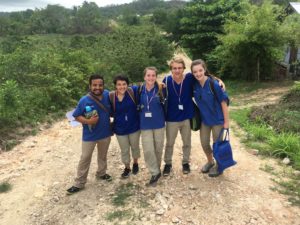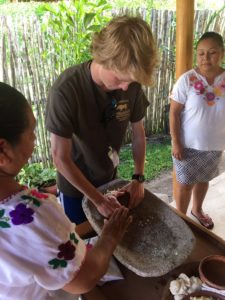Written by Laura Read (GHF ’20) to recount Thursday, June 16, 2017:
It was yet another hot, sunny day in San Antonio. We woke up early to a delicious breakfast of toast, peanut butter, and coffee from our host family mother, Miss Sandra. At 8:00, we headed off to the community center for an activity packed day! It was going to be out last day of home care visits.
The three groups split off again to cover the villages. Gabi, Connor, Claire, Mrs. Goodson, Hector, and I (the Tortilla group strikes again) took the city bus to Cristo Rey, a village about 25 minutes away from San Antonio. We had a interesting conversation with a family about the Belizean education system, which was awesome to hear. The woman we talked to had a lot of insight and a strong opinion on how it should be changed to better the community. Gabi and I got a lot of practice taking glucose levels! I made an effort to practice more of the Spanish I’ve been learning. It’s wildly cool to see how I’m able to understand the conversations the families are having between themselves and Hector. Then, a few hours and some good laughs later, we headed over to the bus stop to travel back to our town.
After our last few visits, we headed back to our home stays for some rest and lunch. Olivia and I had a kind of chicken wrapped in fry jacks and it was incredible. Then I played with Miss Sandra’s adorable son, Norbert, who is five. He’s been so cute this week and I’m going to miss him when we leave!
At 2:00, we all met up in the community center for a tech session. We covered the different uses of ser and estar, listening comprehension, and the pretérito (past) tense in the advanced Spanish group with Hector. I’m learning to think quickly through my Spanish. After our lesson, the groups switched and Kristen (who is awesome and living in my home stay with me) taught us all about maternal health. We learned about maternal mortality, teen pregnancy, family planning, the stages of pregnancy, and maternal health in Belize. It was a really informative presentation!
Then we headed home for a quick dinner. At 7:30 we were to head over to Sahib, Lawson, and Hector’s home stay for a bonfire and some bonding time. We roasted pineapple and marshmallows! We all hung out in the hammocks for ages. It was a great time. Sahib made us all die laughing, as usual. Then we played Mafia in the back of the pick up truck. It was a lot of fun despite Hunt personally turned Johan against me (cough, cough).
Unfortunately, our last round was cut short when the clock struck 9:00, and we all had to say goodbye for the night. We took a few pictures and walked back to our home stays.
I can’t believe tomorrow is our last full day here. I’m going to miss it so much! (especially Norbert.)























 one of the translators who has been assisting us with the Luci light distribution and M&E in Clory. It was so much fun to begin to learn a new language and it helped to make communicating with everyone around us a little easier. Soon after the end of the lesson, the ‘19s joined in on the game of hearts with the ‘17s. It was an amazing experience for everyone to get to know each other better, and it gave us a great relief from the overwhelming heat in Clory yesterday.
one of the translators who has been assisting us with the Luci light distribution and M&E in Clory. It was so much fun to begin to learn a new language and it helped to make communicating with everyone around us a little easier. Soon after the end of the lesson, the ‘19s joined in on the game of hearts with the ‘17s. It was an amazing experience for everyone to get to know each other better, and it gave us a great relief from the overwhelming heat in Clory yesterday.



